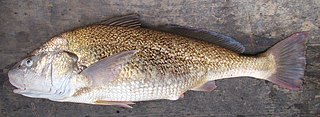
Argyrosomus is a genus of marine ray-finned fishes belonging to the family Sciaenidae, the drums. The fish in this genus are large and are commonly targeted as game fish.

Micropogonias is a genus of marine ray-finned fishes belonging to the family Sciaenidae, the drums and croakers. These fishes are found in the eastern Pacific and western Atlantic Oceans.

Cynoscion is a genus of marine ray-finned fishes belonging to the family, Sciaenidae, the drums and croakers. These fishes are found off the coasts of North and South America in the western Atlantic and eastern Pacific Oceans. Many fishes in this genus have been given the common name weakfish.

Sciaena is a genus of marine ray-finned fishes belonging to the family Sciaenidae, the drums and croakers. These fishes are found in the Eastern Pacific Ocean and the Eastern Atlantic Ocean.

Nebris is a small genus of marine ray-finned fishes belonging to the family Sciaenidae, the drums and croakers. There are two species in the genus, one in the Western Atlantic Ocean and one in the Eastern Pacific Ocean.

Panna is a genus of marine ray-finned fish belonging to the family Sciaenidae, the drums and croakers. These fishes are found in southern and southeast Asia.

Bairdiella is a genus of marine ray-finned fishes belonging to the family Sciaenidae, the drums and croakers. These fishes are found in the western Atlantic and eastern Pacific Ocean.

Atractoscion is a genus of marine ray-finned fished belonging to the family Sciaenidae, the drums and croakers. The fishes in this genus are found in the Atlantic, Indian and Pacific Oceans.

Lonchurus is a genus of marine ray-finned fishes belonging to the family Sciaenidae, the drums and croakers. These fishes are found in the Western Atlantic.

Odontoscion dentex, the reef croaker or brown large-eyed croaker, is a species of marine ray-finned fish belonging to the family Sciaenidae, the drums and croakers. It is found in coral and rocky reefs of the tropical Western Atlantic, living as solitary individuals or in small groups at a depth of 1 to 30 m. This species feeds on small fish, shrimp, and larvae.
The yellowtail croaker, also known as the yellowtail jewfish, is a species of marine ray-finned fish belonging to the family Sciaenidae, the drums and croakers. This species is found in the southwestern Pacific Ocean off northern Australia and southern New Guinea. It is the only species in the monospecific genus Austronibea.

Cheilotrema is a genus of marine ray-finned fishes belonging to the family Sciaenidae, the drums and croakers. These fishes are found in the eastern Pacific Ocean.
Ctenosciaena is a genus of marine ray-finned fishes belonging to the family Sciaenidae, the drums and croakers. These fishes are found in the Western Atlantic and southeastern Pacific Oceans.
The bluestreak drum, also known as the bluish croaker, is a species of marine ray-finned fish belonging to the family Sciaenidae, the drums and croakers. It is the only species in the monospecific genus Elattarchus. This species is found in the central eastern Pacific Ocean along the coasts of the Americas.

Larimus is a genus of marine ray-finned fishes belonging to the family Sciaenidae, the croakers and drums. These fishes are found in the Western Atlantic and Eastern Pacific Oceans.

The cuja bola is a species of marine ray-finned fish belonging to the family Sciaenidae, the drums and croakers. This fish is found in the northern Indian Ocean in India, Bangladesh, Myanmar and Thailand. It is the only species in the monospecific genus Macrospinosa.

Micropogonias furnieri, the whitemouth croaker, golden croaker, hardhead, mangrove snapper, rocandoronco, two-belly bashaw, West Indian croaker, West Indian drum or whitemouth drummer, is a species of marine ray-finned fish belonging to the family Sciaenidae, the drums and croakers. This fish is found in the western Atlantic Ocean.

Odontoscion is a genus of marine ray-finned fish belonging to the family Sciaenidae, the croakers and drums. These fishes are found in the Western Atlantic and Eastern Pacific Oceans.

The half-mourning croaker is a species of marine ray-finned fish belonging to the family Sciaenidae, the drums and croakers. It is the only species in the monospecific genus Paranibea. This fish is found in the Indo-Pacific region.
Protosciaena is a small genus of marine ray-finned fishes belonging to the family Sciaenidae, the drums and croakers. These fishes are found in the Western Atlantic Ocean.















